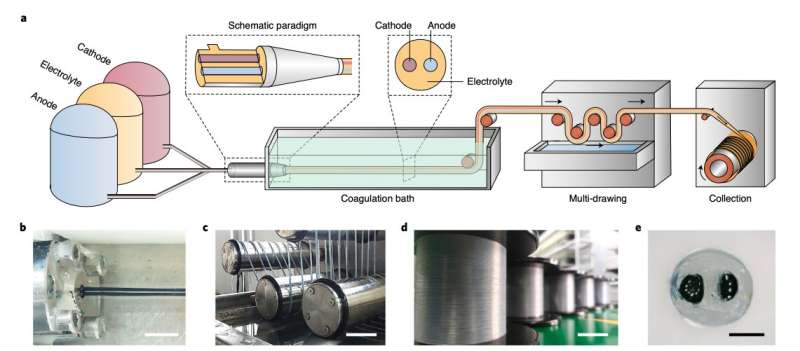Fiber batteries are millimeter-thin batteries based on fibers that can be woven into items of clothing or used to create highly flexible, wearable electronics. In recent years, many research teams worldwide have been trying to fabricate these batteries, using a range of different techniques and approaches.
Most existing techniques for creating fiber batteries entail layer-by-layer coating processes that were adapted from the fabrication of planar batteries, a flat and thin battery technology. Despite their advantages, these processes typically enable the creation of a limited number of batteries at a time, thus they are unsuited for large-scale production.
Researchers at Fudan University in China have recently introduced an alternative method for manufacturing fiber batteries that could be easier to implement on an industrial scale. This method, introduced in a paper published in Nature Nanotechnology, is based on a general, solution-extrusion technique that can produce batches of several fiber batteries in a single step.
The production method proposed by the researchers relies on a spinneret structure, a cap or plate with several small holes on it that is often used to produce fibers. This structure, which has three main extrusion channels, can be used to create fiber batteries composed of a parallel cathode and anode, encapsulated by an electrolyte, with remarkable production rates of 250 m h-1.
“Our three-channel industrial spinneret simultaneously extrudes and combines the electrodes and electrolytes of fiber batteries at high production rates,” Meng Liao and his colleagues explained in their paper. “The laminar flow between functional components guarantees their seamless interfaces during extrusion.”
Compared to existing methods for producing fiber batteries, the researchers’ approach can yield a remarkable 1,500 km of continuous fiber batteries for each individual spinneret unit used. This is over three times more batteries than those produced by the best performing techniques developed so far.
In their paper, Liao and his colleagues demonstrated the high potential of their method by using it to create roughly 10 m2 of fiber battery-based woven textiles. These textiles were specifically designed to be used to create smart and responsive tents and the fiber battery used to power them had an energy density of 550mWhm-2.
The smart tent they designed has several interesting and advanced features. For instance, it can harvest energy from the sun, store it, and use it to control a display and other technologies inside it. In the future, the battery production method introduced by the researchers could be used to create similar tents or other textile-based electronics on a large scale, potentially facilitating their widespread use.
“Our method is straightforward, and the flexible textile battery obtained is stable, durable and safe,” Liao and his colleagues wrote in their paper. “We anticipate that it will promote large-scale production and practical applications of fiber batteries for the next-generation electronics.”
Original Article: Here
Researchers Develop Semi-Liquid Metal Anode for Next-Generation Batteries















